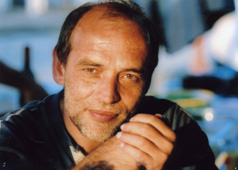News

Introduction to the Concept of Osteopathic Biodynamics
November 25–27, 2011, Saint Petersburg
Bruno Josse is Doctor of Osteopathy, member of Osteopath Register of France. Graduate of the Saterland Institute (France). He had an additional training course at the College of Osteopathy, Association of Manual Therapy, in 1985. He studied biodynamic conceptions in osteopathy under guidance of James Jealous. In 2008 he studied etiomedicine (energetic osteopathy). Has been teaching since 1994.
1994–2002: Head of the cranial sector at the Saterland Osteopathic College. Since 2002: leading instructor at IdHEO (Higher School of Osteopathy, Nantes, France). Since 2003 Dr. Josse has been conducting seminars on biokinetic and biodynamic concepts in osteopathy in France, Germany, the Netherlands, and Italy. Founder of the Federal Council of Osteopaths of France, Academy of Osteopathy and Saterland Cranial Academy (France).
Biodynamic Conception in Osteopathy
"The term "biodynamics" means that material or physical movements characterizing development are caused directly by the natural or innate forces which are present in the live organism." (E. Blechschmidt)
These creating forces are also recovering forces and, consequently, they can heal the patient. In addition to all other functions, they are the internal forces which are often talked about but not determined. Biodynamics promotes understanding of these powerful forces and their proper activation for treatment.
The purpose of the osteopathic biodynamic model is to understand the Force and Intention of Life Respiration. This is a model of investigation based on integration and direct perception of natural laws which place the human in its body-soul-mind concept connecting him or her with Nature, with use of Primary Respiration as the vector (should not be confused with the primary respiration mechanism), what makes it possible to establish interconnections with therapeutic forces of the patient.
The biodynamic approach is based on training in sensory discrimination of Primary Respiration and its different positive effects on the patient. The matter concerns studying the natural laws of Primary Respiration. This is a model initiated by Saterland and then extended by Becker and Jealous makes our movement possible from the Neutral position to the Point of Immobility and to its expression, i.e. Life Respiration. It allows us to obtain access to perception of the Universal Presence of the "Great Architect of the Universe" in its human manifestation of the Shape, Function and Structure.
Thus, the biodynamic model of osteopathy suggests to allow the Primary Respiration to treat the patient as a whole (body-soul-mind) so that all functions of the body may recover their harmony.
"Life is substance which fully fills the space of the whole Universe. It gives shape and movement to physical and intellectual essence simultaneously. One of its abilities consists in selection of the matter quality… and of that what will make… liquids and forces of Nature."
A. T. Still
It allows not to separate the human being from his or her environment or microcosmos and marcrocosmos.
Bruno Josse D.O.
Program of the Seminar
Introduction and brief historical information about the concept of biodynamics
A. Still, U. Saterland, R. Becker, J. Jealous
Brief history of U. Saterland’s practice or how he turned from fixation of the bandage on the patients’ head to understanding of dynamic immobility, life respiration or liquid light.
Semantics
Ideas of equilibrium point, steadiness point, neutral point, immobile point, fulcrums, permitted movement, restricted movement, movement at present moment, dynamic immobility, point therapeutic intervention ending (actual understanding of the moment when the treatment is completed), etc.
Voluntary mechanism, involuntary mechanism, involuntariness. Rhythms
Definitions, concepts, therapeutic interests. Different rhythms (chronic renal (respiratory) insufficiency, flash, long flash, dynamic immobility) and their meanings. Differences between the primary respiration mechanism and primary respiration. Practice in rhythms.
From injury in the patient’s neutral point to the therapeutic process
Seven osteopathic methods: direct action, indirect action, pre-functional methodology, functional methodology, per-biodynamic functional methodology, I and II biodynamic methodologies. Theory and practice.
Live tissues and their mutual tension
- Body-soul-mind or tissues, liquids, and the electromagnetic field.
- Three bodies (physical, liquid body, body depending on flash). Theoretical and practice aspects.
- "All" of the patient.
- Balancing of membrane tensions, balancing of liquid tensions, therapeutic fulcrum, therapeutic activity (five possible local therapeutic techniques), therapeutic process.
- Metabolic function and natural metabolic release.
Liquids
- Dynamics of liquids: liquid-energetic and hydrobiological liquid matrices, liquid in liquid, mutual liquid pressure. Theory and practice.
- Clinical and therapeutic aspects of the liquid: compression of the fourth ventricle. Enlargement of the fourth ventricle. Theory and practice.
- Peculiar power of the vital force.
- Balancing power pressures or balancing of the ortho/parasympathetic nervous system. Theory and practice.
Median line
Undifferentiated median line, embryologic median line of the chord, liquid median line, bioelectric median line (our first function).
Embryology and perception of chord. Practice on the vertebral column: "back string".
Contact information:
Anna Razorenova: +7 812 445 20 92
e-mail: osteo-open@yandex.ru